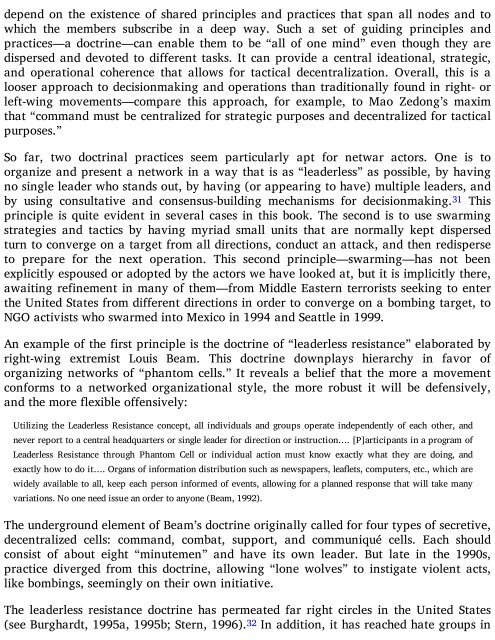RAND_MR1382
You also want an ePaper? Increase the reach of your titles
YUMPU automatically turns print PDFs into web optimized ePapers that Google loves.
depend on the existence of shared principles and practices that span all nodes and to<br />
which the members subscribe in a deep way. Such a set of guiding principles and<br />
practices—a doctrine—can enable them to be “all of one mind” even though they are<br />
dispersed and devoted to different tasks. It can provide a central ideational, strategic,<br />
and operational coherence that allows for tactical decentralization. Overall, this is a<br />
looser approach to decisionmaking and operations than traditionally found in right- or<br />
left-wing movements—compare this approach, for example, to Mao Zedong’s maxim<br />
that “command must be centralized for strategic purposes and decentralized for tactical<br />
purposes.”<br />
So far, two doctrinal practices seem particularly apt for netwar actors. One is to<br />
organize and present a network in a way that is as “leaderless” as possible, by having<br />
no single leader who stands out, by having (or appearing to have) multiple leaders, and<br />
by using consultative and consensus-building mechanisms for decisionmaking. 31 This<br />
principle is quite evident in several cases in this book. The second is to use swarming<br />
strategies and tactics by having myriad small units that are normally kept dispersed<br />
turn to converge on a target from all directions, conduct an attack, and then redisperse<br />
to prepare for the next operation. This second principle—swarming—has not been<br />
explicitly espoused or adopted by the actors we have looked at, but it is implicitly there,<br />
awaiting refinement in many of them—from Middle Eastern terrorists seeking to enter<br />
the United States from different directions in order to converge on a bombing target, to<br />
NGO activists who swarmed into Mexico in 1994 and Seattle in 1999.<br />
An example of the first principle is the doctrine of “leaderless resistance” elaborated by<br />
right-wing extremist Louis Beam. This doctrine downplays hierarchy in favor of<br />
organizing networks of “phantom cells.” It reveals a belief that the more a movement<br />
conforms to a networked organizational style, the more robust it will be defensively,<br />
and the more flexible offensively:<br />
Utilizing the Leaderless Resistance concept, all individuals and groups operate independently of each other, and<br />
never report to a central headquarters or single leader for direction or instruction…. [P]articipants in a program of<br />
Leaderless Resistance through Phantom Cell or individual action must know exactly what they are doing, and<br />
exactly how to do it…. Organs of information distribution such as newspapers, leaflets, computers, etc., which are<br />
widely available to all, keep each person informed of events, allowing for a planned response that will take many<br />
variations. No one need issue an order to anyone (Beam, 1992).<br />
The underground element of Beam’s doctrine originally called for four types of secretive,<br />
decentralized cells: command, combat, support, and communiqué cells. Each should<br />
consist of about eight “minutemen” and have its own leader. But late in the 1990s,<br />
practice diverged from this doctrine, allowing “lone wolves” to instigate violent acts,<br />
like bombings, seemingly on their own initiative.<br />
The leaderless resistance doctrine has permeated far right circles in the United States<br />
(see Burghardt, 1995a, 1995b; Stern, 1996). 32 In addition, it has reached hate groups in










![Genki - An Integrated Course in Elementary Japanese II [Second Edition] (2011), WITH PDF BOOKMARKS!](https://img.yumpu.com/58322134/1/180x260/genki-an-integrated-course-in-elementary-japanese-ii-second-edition-2011-with-pdf-bookmarks.jpg?quality=85)
![Genki - An Integrated Course in Elementary Japanese I [Second Edition] (2011), WITH PDF BOOKMARKS!](https://img.yumpu.com/58322120/1/182x260/genki-an-integrated-course-in-elementary-japanese-i-second-edition-2011-with-pdf-bookmarks.jpg?quality=85)





